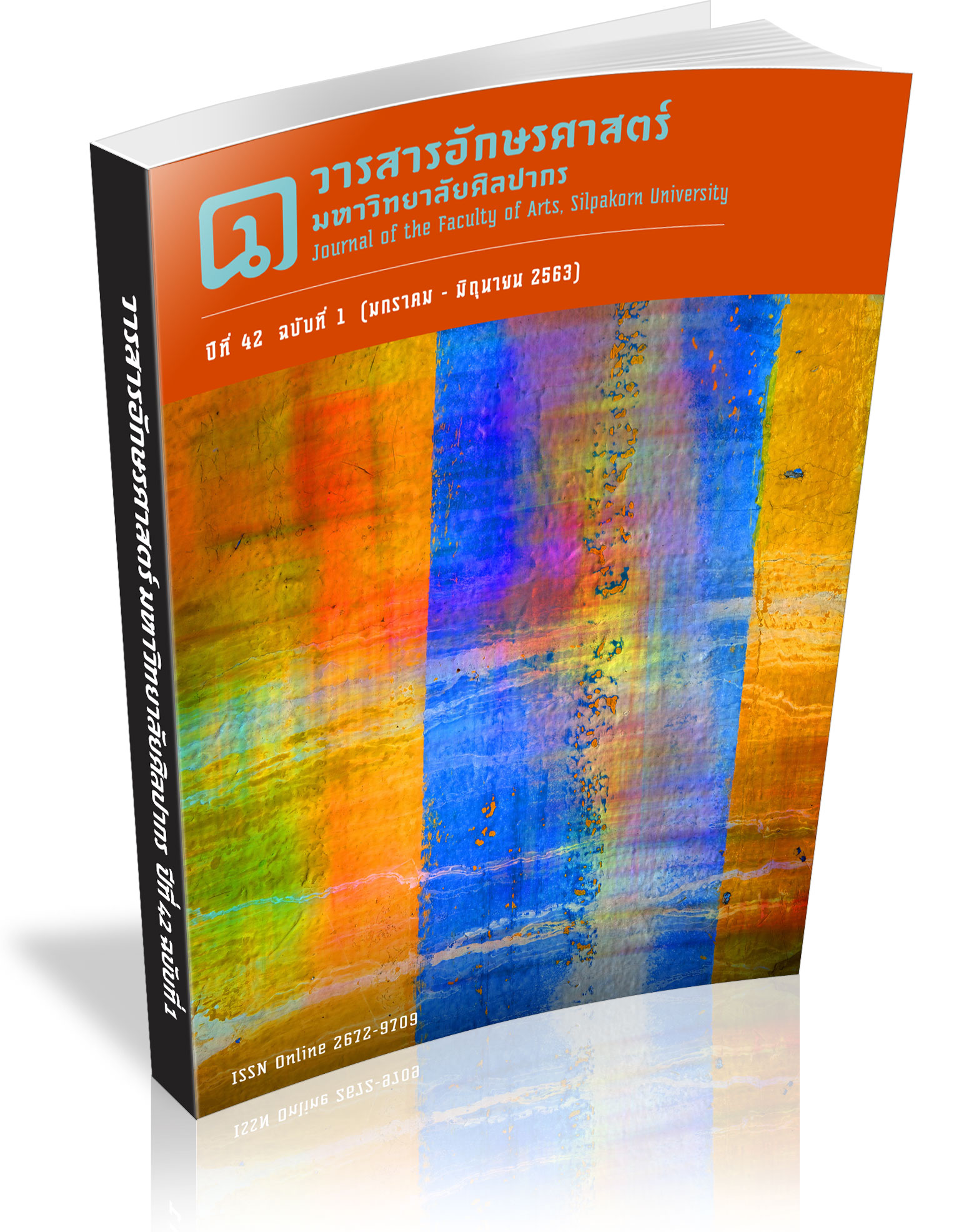อุปลักษณ์ “心 /ɕin55/ (ใจ)” ในภาษาจีน ด้วยการวิเคราะห์การหลอมรวมมโนทัศน์: กรณีศึกษาคำผกผันที่มีหน่วยคำเดียวกัน
คำสำคัญ:
กระบวนการกลายเป็นอุปลักษณ์, คำผกผันที่มีหน่วยคำเดียวกัน, ทฤษฎีการหลอมรวมมโนทัศน์, อุปลักษณ์ “ใจ”บทคัดย่อ
บทความฉบับนี้มีวัตถุประสงค์มุ่งที่จะวิเคราะห์อุปลักษณ์ 心 /ɕin55/ (ใจ) ในภาษาจีนโดยจะเป็นกรณีศึกษาเฉพาะคำว่า 心 /ɕin55/ (ใจ) ปรากฏร่วมกับคำอื่น ๆ เพื่อกลายเป็นคำผกผันที่มีหน่วยคำเดียวกันตามแนวคิดการหลอมรวมมโนทัศน์ ผลการศึกษาพบว่า การใช้คำว่า 心 /ɕin55/ (ใจ) ในภาษาจีนเป็นอุปลักษณ์และมีความหมายเปรียบเทียบที่อ้างถึงคน ความคิด อารมณ์ความรู้สึก ลักษณะนิสัย และตำแหน่งในพื้นที่ ส่วนความหมายเปรียบเทียบของ 心 /ɕin55/ (ใจ) ในคำผกผันที่ประกอบด้วยหน่วยคำเดียวกันทั้งสองคำนั้นไม่่ได้มีความหมายเหมือนกันเสมอไป แต่บางครั้งกลับมีความหมายที่ต่างกัน ขึ้นอยู่กับความหมายใหม่ที่ปรากฏในพื้นที่ความคิดหลอมรวม และความสัมพันธ์ระหว่างความหมายของคำที่จัดอยู่ในพื้นที่ความคิดรับเข้าสองพื้นที่ การสลับตำแหน่งหรือสลับพื้นที่ความคิดของหน่วยคำอาจมีผลต่อคำใหม่ที่สร้างขึ้นมาแสดงความหมายต่างกัน รวมทั้งยังทำให้ความหมายเปรียบเทียบของ 心 /ɕin55/ (ใจ) แตกต่างกันออกไปอีกด้วย อย่างไรก็ดี การนำทฤษฎีการหลอมรวมมโนทัศน์มาใช้ในการพิจารณาคำว่า 心 /ɕin55/ (ใจ) และคำที่ปรากฏร่วม สามารถช่วยให้เห็นถึงกระบวนการกลายเป็นอุปลักษณ์ของคำว่า 心 /ɕin55/ (ใจ) ในภาษาจีนได้ละเอียดและแจ่มชัดยิ่งขึ้น
Downloads
เอกสารอ้างอิง
Dou, Xiaolei. (2012). Xiàn Dài Hàn Yǔ Tóng Sù Nì Xù Tóng Yì Cí Yán Jiū 现代汉语同素逆序同义词研究 [The Study of Same-morpheme and Contrary-order Synonym in Contemporary Chinese]. Master thesis, Shandong University. (In Chinese)
Evans, V., & Green, M. (2006). Cognitive Linguistics: An introduction. Edinburgh: Edinburgh University Press.
Fauconnier, G., & Turner, M. (1996). Blending as a central process of Grammar. Conceptual structure, discourse, and language. Standford: CSLI Pubulications.
Fauconnier, G., & Turner, M. (1998). Conceptual integration networks. Cognitive science, 22(2), 133-187.
Fauconnier, G., & Turner, M. (2002). The Way We Think: Conceptual Blending and the Mind's Hidden Complexities. New York: Basic Books.
He, Xinlian. (2016). Hàn Tài Yǔ Nì Xù Cí Duì Bǐ Fēn Xī 汉泰语逆序词对比分析 [Comparing the Word Opposite Order between Chinese and Thai]. Master thesis, Guangxi Institute for Nationalities. (In Chinese)
He, Zhihua. (1988). Guō Zhù Shuāng Yīn Cí Zhōng De Tóng Sù Fǎn Xù Xiàn Xiàng 郭注双音词中的同素反序现象 [The Phenomenon of homologous Reverse Order in Guo Zhu's Two-syllable Words]. Journal of Nanchang University (Humanities and Social Sciences), (2), 104-106. (In Chinese)
Hu, Wei. (2015). Tóng Sù Nì Xù Cí Jí Qí Duì Wài Hàn Yǔ Jiào Xué Yán Jiū 同素逆序词及其对外汉语教学研究 [Research on ReverseMorpheme Word Pairs and Teaching Chinese as a Foreign Language]. Master thesis, East China Normal University. (In Chinese)
Huang, Shuyun. (2016). Duì Wài Hàn Yǔ Jiào Xué Zhōng Duì Tóng Sù Nì Xù Cí Chǔ Lǐ De Duō Miàn Kǎo Chá Yǔ Fēn Xī 对外汉语教学中对同素逆序词处理的多面考察与分析 [A Multifaceted Investigation and Analysis on the processing of Inverse Morphemes Words in Teaching Chinese as a Foreign Language]. Master thesis, Guangzhou University. (In Chinese)
Jia, Yuping. (2010). Xiàn Dài Hàn Yǔ Tóng Sù Nì Xù Cí Gòu Cí Zào Cí Yán Jiū 代汉语同素逆序词构词造词研 [Research on Wordformation and Wordmaking of Modern Chinese Inverse Morphemes Words]. Master thesis, Shandong Normal University.
(In Chinese)
Lakoff, G. & Johnson, M. (1980). Metaphors We Live By. Chicago, IL: University of Chicago Press.
Lakoff, G. & Johnson, M. (2003). Metaphors We Live By. Chicago, IL: University of Chicago Press.
Li, Qin. (2016). Guān Yú Zhōng Rì Hàn Zì Cí De Duì Bǐ Yán Jiū 于中日汉字词的对比研究 [A Contrastive Study on ChineseJapanese Characters]. Master thesis, Harbin University of Technology. (In Chinese)
Liu, Xiaoqin. (2013). Xiàn Dài Hàn Yǔ Lián Hé Shì Tóng Sù Nì Xù Cí Lì Shǐ Kǎo Chá 现代汉语联合式同素逆序词历史 [Historical Research of Modern Chinese Combined Inverse Morphemes Words]. Master thesis, Shandong Normal University. (In Chinese)
Lou, Xue’er. (2013). Hàn Rì Tóng Sù Nì Xù Cí De Duì Bǐ Yán Jiū Jí Xiāng Guān Cí De Jiào Xué Jiàn Yì 汉日同素逆序词的对比研究及相关词的教学建议 [Contrastive Study of Chinese and Japanese Inverse Morphemes Words and Teaching Suggestions on Related Words]. Master thesis, Shanghai International Studies University. (In Chinese)
Nawawan, Panthumetha. (2016). Treasury of Words. 8th ed. Bangkok: Amarin. (In Thai)
Qian, Li. (1992). Gǔ Dài Hàn Yǔ Tóng Sù Nì Xù Cí Lì Shí Yǎn Gé Qiǎn Tàn 古代汉语同素逆序词历时演革浅探 [A Diachronic exploration of the Inverse Morphemes Words in Ancient Chinese]. Journal of Hangzhou Normal College (Humanities and Social Sciences), (5), 59-62. (In Chinese)
Qu, Yanan. (2017). 《 Wú Xī Bái Huà Bào Bái Huà Cí Huì Yán Jiū《无锡白话报》白话词汇研 [The Study on Vernacular Vocabulary of Wuxi Vernacular Newspaper]. Master thesis, Minnan Normal University. (In Chinese)
Saeed, J. (2003). Semantics, 2nd ed. Oxford: Blackwell Publishing.
Song, Lili. (2009). Zhōng Rì Tóng Sù Nì Xù Cí Yán Jiū 日同素逆序词研 [SinoJapanese Studies with the Morphemereverse Word]. Master thesis, Liaoning Normal University. (In Chinese)
Yang, Shuqiang. (2017). Qiān Gǔ Míng Rén Jìng Fēng Liú 古名人竞风流 [Thousands of ancient celebrity competition]. Hebei: Hebei Fine Arts Publishing House. (In Chinese)
Yu, Chao. (2017). HSK Cí Huì Dà Gāng Tóng Sù Nì Xù Cí Kǎo Chá Jí Jiào Xué Jiàn Yì HSK 汇大纲同素逆序词考查及教学建议 [Investigation and Teaching Suggestions of Reverseordered Words Formed with the Same Morphemes in the HSK Wordlist].
Master thesis, Central China Normal University. (In Chinese)
Yu, Xiaowei. (2016). Jī Yú Duì Wài Hàn Yǔ Jiào Xué De Xiàn Dài Hàn Yǔ Tóng Sù Nì Xù Cí Kǎo Chá 基于对外汉语教学的现代汉语同素逆序词考察 [Research on Modern Chinese Inverse Morphemes Words Based on Teaching Chinese as a Foreign Language]. Master thesis, Guangxi Normal University. (In Chinese)
Zhang, Junya. (2017). Duì Wài Hàn Yǔ Jiào Cái Zhōng Hàn Yǔ Tóng Sù Nì Xù Cí Shì Yì Yán Jiū 对外汉语教材中汉语同素逆序词释义研究 [A Study on the Interpretation of Chinese Same Word in the Teaching Chinese as a Foreign Language]. Master thesis, Harbin Normal University. (In Chinese)
Zhang, Wei. (2002). Hàn Yǔ Tóng Sù Nì Xù Cí Lèi Xíng Hé Chéng Yīn Tàn Xī 汉语同素逆序词类型和成因探析 [The Investigation and Analysis for the Tpye and Cause of Formation of Chinese Inverse Morphemes Word Pairs]. Master thesis, Shaanxi Normal University. (In Chinese)
Zhang, Wei. (2005). Zhōng Gǔ Hàn Yǔ Tóng Sù Nì Xù Cí Yǎn Biàn Yán Jiū 古汉语同素逆词演变研究 [A Study on the Evolution of Inverse Morphemes Words in ancient Chinese]. Doctoral dissertation, Fudan University. (In Chinese)
Zhang, Yongzhe. (2016). Guān Zhōng Fāng Yán Cí Huì Yán Jiū 中方言词汇研 [A Study on Vocabulary Correspondences in Guandong]. Doctoral dissertation, Shaanxi Normal University. (In Chinese)
Zou, Wen. (2003). Rì Yǔ Hàn Zì Cí Yǔ Hàn Yǔ Xiāng Guān Cí Huì De Duì Bǐ Fēn Xī 语汉字词与汉语相关词汇的对比 [A Comparative and Contrastive Analysis of the Japanese Chinese Characters and their Corresponding Chinese Words]. Doctoral dissertation, Central China Normal University. (In Chinese)
ดาวน์โหลด
เผยแพร่แล้ว
รูปแบบการอ้างอิง
ฉบับ
ประเภทบทความ
สัญญาอนุญาต
ผู้เขียนบทความต้องยินยอมในข้อกำหนดต่าง ๆ ของวารสารก่อนส่งบทความตีพิมพ์




